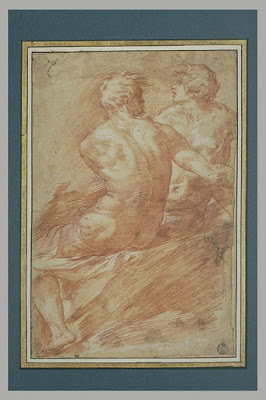 |
| attributed to Nicolò dell'Abate Two Seated Figures before 1571 drawing Musée du Louvre |
 |
| Giovanni Alberti Study for Ignudo ca. 1596-1600 drawing Musée du Louvre |
 |
| Amico Aspertini Christ at the Column before 1552 drawing Musée du Louvre |
 |
| Jacopo Bertoia Hercules, Omphale, and another Figure before 1574 drawing Musée du Louvre |
 |
| Agnolo Bronzino King Midas ca. 1560 drawing Musée du Louvre |
 |
| Bernardino Campi River God before 1591 drawing Musée du Louvre |
 |
| Pietro Faccini Figure Study ca. 1590-1600 drawing Musée du Louvre |
 |
| Pietro Faccini Figure Study ca. 1590-1600 drawing Musée du Louvre |
 |
| Girolamo Genga Figure Study ca. 1525-30 drawing Musée du Louvre |
 |
| Innocenzo da Imola Figure Study before 1548 drawing Musée du Louvre |
 |
| Anonymous Florentine Artist Figure Study 16th century drawing Musée du Louvre |
 |
| attributed to Giovanni Paolo Lomazzo Figure Study ca. 1560 drawing Musée du Louvre |
 |
| Girolamo Macchietti Half-Length Figure Study ca. 1573 drawing Musée du Louvre |
 |
| Bartolomeo Passarotti Venus and Adonis before 1592 drawing Musée du Louvre |
 |
| Polidoro da Caravaggio Reclining Cupid before 1543 drawing Musée du Louvre |
"The human figure cannot be understood merely through the observation of its surface: the interior must be laid bare, the parts must be separated, the connexions perceived, the differences noted, action and reaction observed, the hidden, constant, fundamental elements of the phenomena impressed on the mind, if we really wish to contemplate and imitate what moves in living waves before our eyes as a beautiful, unified whole. For the German artist, and for the modern and northern artist in general, the transition from formlessness to form, and the maintenance of form once attained, is difficult, nay, almost impossible. Let any artist who has spent some time in Italy ask himself whether contact with the best examples of ancient and modern art has not inspired him with the desire to study and imitate the human figure, its proportions, forms and character, and to spare no pains in this pursuit, to come close to the autonomy of those works and to produce something that both satisfies the sense and, at the same time, lifts the soul into its highest regions. But he must also confess that, after his return, his efforts relaxed little by little, for he found few who saw truly what he represented, but only such as regard a work superficially for its agreeable suggestion, and who feel and enjoy something after their own fashion. The worst picture can speak to our perception and imagination, for it sets them in motion, makes them free, and leaves them to themselves. The best also speaks to our perceptions, but in a higher language, one certainly which has to be understood, but which chains our feelings and our imagination and robs us of our will-power, for we cannot do what we please with the perfect, we are compelled to surrender to it in order to receive ourselves again, raised and ennobled."
– Johann Wolfgang Goethe, from Introduction to the Propyläen (1798), translated by John Gage